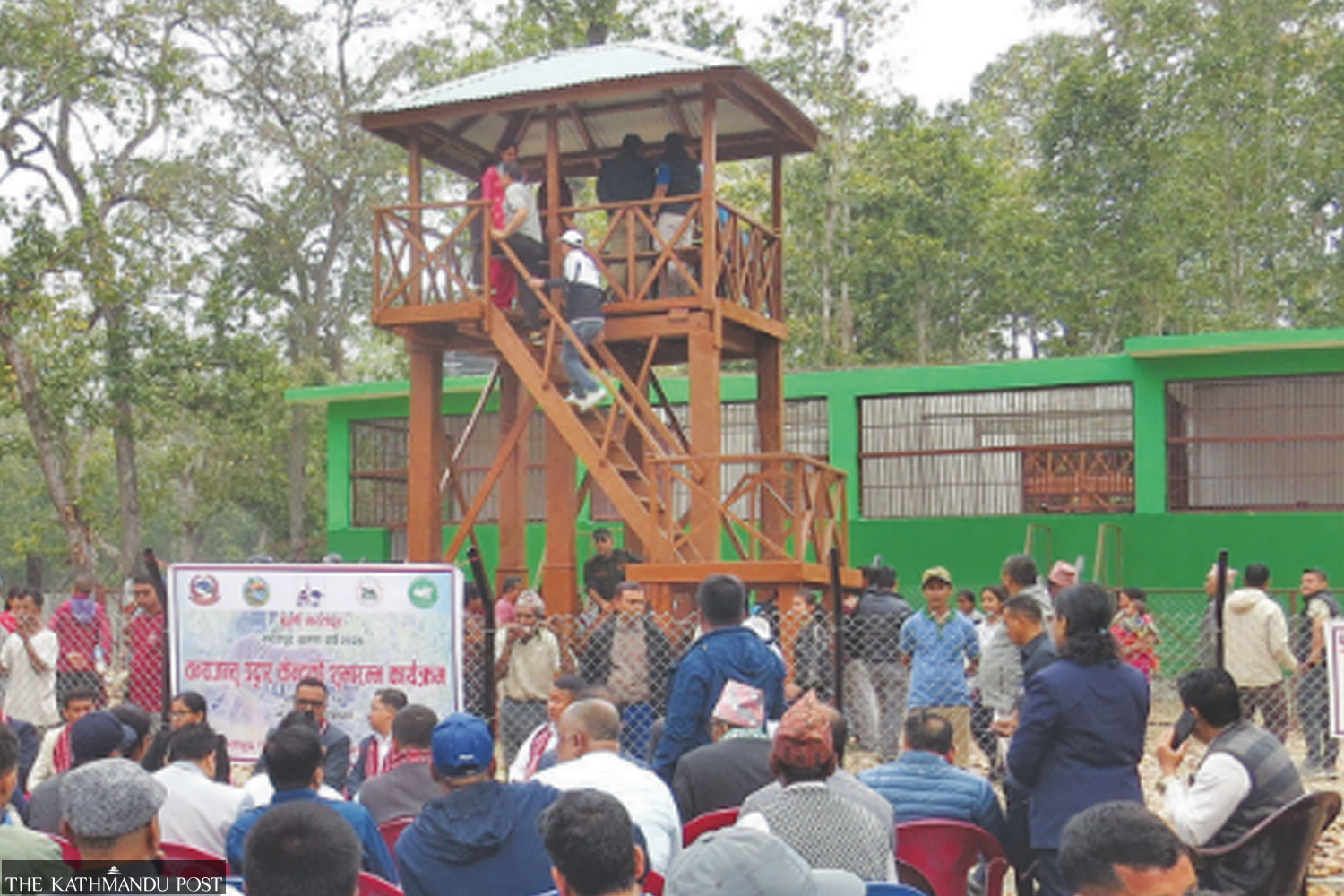National
Chitwan National Park sets up tiger enclosures with observation towers to attract more visitors
The plan is to charge fees to visitors and the money will be spent on the operation of the enclosures, where troublesome tigers are captured and kept.
Ramesh Kumar Paudel
The Chitwan National Park (CNP), the country’s first national park, has some respite in managing captive tigers with the establishment of a zoo-like animal rescue centre in a buffer zone forest. General public can visit the centre and watch the endangered species after paying a fee.
The rescue centre, with the capacity to accommodate two tigers, was set up in collaboration with the CNP and Bharatpur Metropolitan City at Devanagar in ward 6 of Bharatpur Metropolitan City. The centre is at the edge of the Dakshinkali Buffer Zone Community Forest.
“It (CNP) is such a big national park. There are more than 100 tigers. Rhinos, spotted deer, and wild boars, among other animals are easily seen. But most visitors hardly get to see tigers. People who want to see tigers will certainly visit this place now onwards,” said Bharatpur mayor Renu Dahal while inaugurating the centre on Wednesday.
According to the latest tiger census held in 2021, the tiger population in Nepal has reached 355, with the country nearly tripling the number in 12 years. Chitwan is a major habitat for tigers with the CNP hosting 128 big cats in its forests and surrounding areas.
“Two captive tigers kept in enclosures in Kasara have been shifted to the rescue centre. The main objective of setting up the centre is to keep and conserve the trouble-making tigers rescued from various places. Interested people can also visit the centre by buying a ticket,” said Ganesh Prasad Tiwari, information officer at the CNP.
According to Tiwari, both tigers kept in the rescue centre are male. One was rescued from the Banke National Park two years ago while the second was captured from the Patihani area near Kasara, Chitwan.
The recently-established rescue centre is around seven kilometers to the south of Godrang in Bharatpur. Two concrete enclosures measuring 53 by 40 feet each have been constructed to keep the tigers. The enclosures are 12.4 feet high. Two high wooden machans (observation towers) have been constructed for the visitors to watch tigers.
The authorities are yet to decide about the entrance fees for visitors. “The National Trust for Nature Conservation has the authority to collect entry fees as per the prevailing legal provisions. We will soon make guidelines in accordance with the legal provision. The collected amount will be spent mainly for care and conservation of the wildlife kept in the centre,” said Tiwari.

According to conservationists, a huge amount of money is spent for the care of the captive tigers. “Around four kilograms of buffalo meat should be provided to a tiger on every alternate day. At least one employee should be assigned to look after each captive tiger,” said Tiwari, adding that the entry fees would significantly help in sustaining the centre’s expenditures.
Nepal successfully achieved its goal of doubling the tiger population by 2022, as per its commitment made during the first tiger summit in 2010 in St Petersburg. While the increase in the tiger population has positive indications for wildlife conservation, it has come with its own set of challenges for the country, the major one being the reduction of human-tiger conflict and the rehabilitation of captive tigers.
Conservation authorities have to rescue the ‘trouble-making’ tigers that enter the settlements and attack humans. Human casualties triggered by human-tiger conflict can be reduced significantly if the ‘trouble-making’ tigers are captured and kept in captivity, according to Tiwari.
“We have a similar experience. A total of 16 people were killed by tigers in Chitwan areas in the fiscal year of 2021-22. There was just one human death caused by tiger in the fiscal year of 2022-23 after the national park started capturing the trouble-making tigers and keeping them in enclosure,” he said.
However, almost all the enclosures available across the nation are full of captive tigers. The CNP has altogether six cages—four in Kasara and two in Sauraha—for captive tigers. The Bardiya National Park, which is home to 125 tigers, has cages that can accommodate up to five captive tigers while the Parsa National Park has two such cages.
According to conservationists, all captive tigers which are currently in cages in various parks are troublesome and cannot be released into the wild. They argue that the captive tigers, in case they are released in the wild again, return to human settlements and cause trouble. So, many wildlife rescue centres should be set up in the country to keep the captive tigers, say conservationists.




 6.12°C Kathmandu
6.12°C Kathmandu1.jpg)













%20(1).jpg&w=300&height=200)

